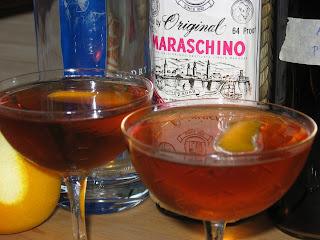Imagine yourself in a dimly lit room, a sliver of orange peel precariously balanced between your thumb and forefinger. The faint smell of sulfur from a recently lit match still lingers as you watch the flame throbbing on the end of the wood. With the right amount of pressure and the proper aim, a puff of citrus oils flashes, and those toasted oils land lightly on the surface of an awaiting drink. It is a mark of pure showmanship. Sure, those oils will add flavor to the overall taste of the drink, but they are still the garnish. Perhaps less than one dash of citrus oils are flambeed midair. But as with all other drinks calling for citrus oils, whether they are "cooked" or "raw," they are a necessary and delicious.
For months the elusive flamed orange peel has stumped me. Every time I tried, which to be honest wasn't that often, I ended up with many spent matches, a skinned orange and no orange oils anywhere near my drink. Sometimes I just copped out--twisting the orange peel over the glass and calling it a day. I would say to myself, "What does it really matter? How much can it mean to the drink?" In this case, it was a skill well worth learning.
This past weekend I decided that no longer would I cower before the flamed orange peel. Armed with two oranges, my trusty Y peeler and a box full of sturdy matches, I set about my task. After three or four tries, I was able to get a consistent spurt of oils into an empty glass. When I starting adding the flame, it became that much easier. And after a few more tries, I was able to create that flashy effect pretty much every time. It turns out that I had built up the idea that flaming oranges was this impossible task, but it really isn't. I just needed to break it down and practice.
What I learned is that a fresh orange is the most critical part of the equation. Given that citrus is not yet in season, I was at a disadvantage. And while the Valencia oranges that my local supermarket carries year-round are perfect for juicing, they are not the best for flaming. The peel just has too much give. And once I figure that out, charring those oils became a lot easier. The ultimate test was still ahead of me, it was time to garnish an actual drink and I chose Chuck Taggert's delicious Hoskins cocktail.
So enough about garnishes. The Hoskins fits well into the category of brown, bitter and stirred, though it doesn't have a brown spirit in it. It achieves its brown color thanks to one of my favorite things: Amer Picon. A cousin to the Fin de Siecle and the Don't Give Up the Ship, and even perhaps a more distant relative of the Paul's Own Cocktail and the Hanky Panky (though the list goes on), the Hoskins is a cocktail that primarily turns upon the glorious combination of gin and amari. The differences comes with the choice of amari and those other little additions that make each cocktail unique and in this case, very tasty. The Hoskins, though, utilizes more of the amaro and completely removes the sweet vermouth that all of the other cocktails include. This is also what makes it genius.
Hoskins Cocktail
2 ounces gin
3/4 ounce Amer Boudreau
1/2 ounce maraschino liqueur
1/4 ounce Cointreau
1 dash orange bitters
Combine all ingredients in a mixing glass filled with ice. Stir and strain into a chilled cocktail glass. Knock your friends socks off with a flamed orange peel.
Notes on Ingredients: I used Bellringer for the gin, Maraska for the maraschino, and the orange bitters were Fees.
I must say that anything combining gin and an amaro is likely to produce a cocktail I will adore. And this drink fits well with that statement. The maraschino and orange liqueurs were a great addition and provided a lot of depth and balance. The mild sweetness, and I mean mild, that they contributed was just enough to tone down the bold flavors of the amer and gin. The dominant flavors shifted around a bit as the drink warmed up, sometimes highlighting the earthy bitter orange notes so prevalent in the amer, sometimes provoking the funky dry cherry of the maraschino into the spotlight. This worked in the drink's favor as I tend to remember drinks that are complicated better than ones that resound on a single note--unless that one note is sublime. All in all the Hoskins was both bitter and sweet, herbal and complex, and the flamed orange oils added just that little bit of oomph that made this drink complete.
10.18.2010
Subscribe to:
Comments (Atom)
